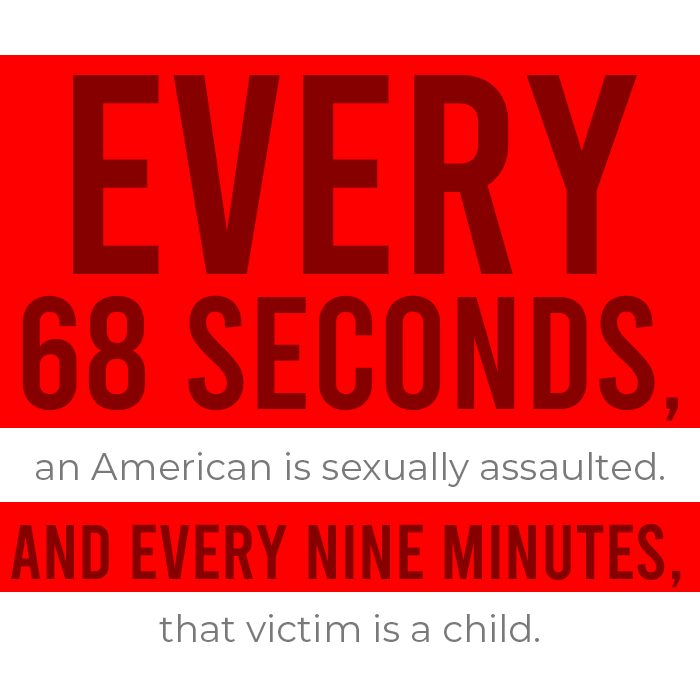At SAFE, we have served survivors of sexual assault for over 45 years. We know that acts of violent, coercive control—like rape and incest—steal so much from a person, including any agency they felt over their bodies. SB 8 serves as another traumatic attack on survivors.
A six week timeline to address an unwanted pregnancy as a result of rape and incest will only serve to increase their pain.
Every 68 seconds, an American is sexually assaulted. And every nine minutes, that victim is a child. Ending rape and incest in Texas is a laudable goal, and one that is unlikely to be achieved in our lifetimes. Texas must not further traumatize and victimize these survivors of rape and incest by taking away further decisions over their bodies, decisions that are a direct result of the heinous crimes committed against those very bodies.
In Texas, only 9.2% of victims report sexual violence to law enforcement, meaning that more than 90% of assaults are unreported. According to crime reporting statistics from the state of Texas for 2019, 82.8% of those reported sexual assaults were committed by someone known to the survivor.
Most rapists are not lurking in back alleys and on our streets, and sexual assault is seldom a one-time incident. The large majority of sexual assaults happen in homes and places formerly considered safe. Too often, sexual predators hide out in the guise of a partner, parent, friend, family member, and confidant.
94% of women who are raped experience symptoms of post-traumatic stress disorder (PTSD) during the two weeks following the rape.
Consider 16-year-old Margaret, who was trafficked for sex by her older cousin. Imprisoned in the life, she was raped by strangers multiple times a day. To survive, Margaret found various ways to dissociate from what was happening to her, including pretending that she was miles away on a desert island. Margaret was so disconnected from her body and her tortuous reality that she did not realize she was pregnant until well past the 6-week deadline in SB 8.
Rape and incest are physical, mental, and emotional attacks that often leave the survivor with post-traumatic stress disorder and/or strong dissociation. While PTSD can drastically decrease cognitive functioning, dissociation can lead to a detachment from reality, including the realization that a violent sexual assault has left you pregnant.
Both PTSD and dissociation also cause survivors to not seek care—mental or physical—for many weeks. Even when counselors know that the survivor has been assaulted, it can take up to 7-8 sessions before a survivor feels comfortable and has established enough trust in the therapeutic relationship to begin reprocessing the trauma.
93% of perpetrators of child sexual abuse are known to the victim.
14-year-old Olivia lived with her father, who repeatedly, incessantly raped her and would not allow her to leave the house. She lived in rural Travis County, was not allowed to attend school or to have access to a phone. When she found the SAFEline on the computer and chatted with our advocate, SAFE helped get her out of the home and away from her father. But Olivia was pregnant and alone and 14 years old.
In addition, women and girls’ bodies traumatized by sexual assault, and certainly by repeated rape or incest, frequently do not behave in regular monthly cycles. This leads the survivor to become unfamiliar with their own biological rhythms, including if they are pregnant. At six weeks after the beginning of their last menstrual cycle, many, if not most, survivors of sexual assault don’t even know they have been impregnated by their rapist.
1 out of every 6 American women has been the victim of an attempted or completed rape in her lifetime, and more than a third of all Texans have experienced some form of sexual assault in their lifetime.
Children who experience abuse or neglect are 2 to 3 times more likely to experience violence and abuse as adults.
Bea married a man out of love—but then he began physically and sexually assaulting her. Bea was heartbroken and lost, and then after another rape by her husband she became pregnant. Unable to take care of herself, Bea had a child that she was entirely unable and unready to parent. Eventually, Child Protective Services took the child and placed them in the foster care system.
At SAFE, we know that violence and abuse frequently occur in an intergenerational cycle; people learn from their families that love means controlling someone with threats, intimidation, violent force, and coercive tactics. Too often, survivors are trapped in their homes with the perpetrator, unable to meet the 6-week restriction. And, too often, these are destructive patterns that are repeated across generations.
After 45 years of listening to survivors of sexual assault and violence, rape, and incest, SAFE is clear that the most important aspect for healing is returning to survivors the power and control over their own lives. Importantly, survivors of rape and incest must have control over the scene of the crime—their bodies.
SAFE Co-CEOs
Kelly White and Julia Spann
Survivors names have been changed to protect their identities.
